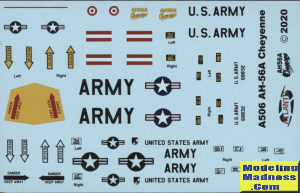
Atlantis 1/72 AH-56A Cheyenne
| KIT #: | A506 |
| PRICE: | ~$20.00 |
| DECALS: | One option |
| REVIEWER: | Scott Van Aken |
| NOTES: | Reboxing of S |

| HISTORY |
The Lockheed AH-56 Cheyenne was an attack helicopter developed by Lockheed for the United States Army. It rose from the Army's Advanced Aerial Fire Support System (AAFSS) program to field the service's first dedicated attack helicopter. Lockheed designed the Cheyenne using a four-blade rigid-rotor system and configured the aircraft as a compound helicopter with low-mounted wings and a tail-mounted thrusting propeller driven by a General Electric T64 turboshaft engine. The Cheyenne was to have a high-speed dash capability to provide armed escort for the Army's transport helicopters, such as the Bell UH-1 Iroquois.
In 1966, the Army awarded Lockheed a contract for ten AH-56 prototypes, but as a stopgap also ordered the less complex Bell AH-1G Cobra as an interim attack aircraft for combat in Vietnam War. The AH-56's maiden flight took place on 21 September 1967. In January 1968, the Army awarded Lockheed a production contract, based on flight testing progress. A fatal crash and technical problems affecting performance put Cheyenne development behind schedule, resulting in the cancellation of the production contract on 19 May 1969. Development of the Cheyenne continued in the hope that the helicopter would eventually enter service.
As American involvement in Vietnam was winding down, the Army canceled the Cheyenne program on 9 August 1972. By this time, the AH-1 Cobra was widely deployed by the Army during the Vietnam War and equipped with the TOW anti-tank missile. Controversy with the United States Air Force over the Cheyenne's role in combat as well as the political climate regarding military acquisition programs had caused the Army to amend the service's attack helicopter requirements in favor of a twin-engine conventional helicopter, viewed as less technical and more survivable. The Army announced a new program for an Advanced Attack Helicopter (AAH) on 17 August 1972, which led to the development of the Hughes AH-64 Apache.
| THE KIT |
This kit was originally released in 1968 by Aurora and re-issued multiple times until the mid 1970s when Aurora was purchased by Monogram (which was then purchased by Revell). With the purchase of Revell by a German company, all of the old Aurora molds and the box scale Revell kits of the 1950s and 1960s were bought by Atlantis. Atlantis has been cleaning up these old kit molds and reissuing them. This is one of those reissues that was released this year (2020).
The tooling looks surprisingly good with the parts being flash free. As you'd expect from a kit of the 60sthe cockpit is quite Spartan with a floor section, two seats, two crew members and an instrument panel along with a cyclic control for the rear seat pilot. This assembly is trapped between the two fuselage halves along with the turret, minigun shape, and main rotor shaft.
The two sponsons and wing assemblies are then attached to the fuselage sides along with the horizontal stabilizers, two smaller propellers, and the engine intakes. Main gear is then attached to the sponsons (tail gear is molded in place on one fuselage half.)
Rest of the assembly concentrates on building up the rotor
and attaching the fairly thick canopy. That is it. Aurora kits were never known
to be complex. There are no pylons or weapons.
Instructions look like what was in the original boxing with generic color information. The lone option is supposed to be painted dark green and tan on the upper surface with light grey undersides. Most were an overall gloss olive drab. There are multiple photographs of a built up helicopter to help you with markings placement. The 'net also provides a lot of images to help you. Decals are nicely done and tons better than what you'd get from an original boxing.
| CONCLUSIONS |
This one is a bit of a trip down memory lane for many of us. The model in the photos looks to be fairly nice as things go so will make for a nice addition to your collections. One thing that is right out of the 60s that that many of the parts had left the sprues by the time I'd opened the box.
| REFERENCES |
https://en.wikipedia.org/wiki/Lockheed_AH-56_Cheyenne
July 2020 Copyright ModelingMadness.com. All rights
reserved If you would like your product reviewed fairly and fairly quickly, please contact the editor or see other details in the
Note to
Contributors. Back to the Main Page
Back to the Review
Index Page
Back to the Previews Index Page